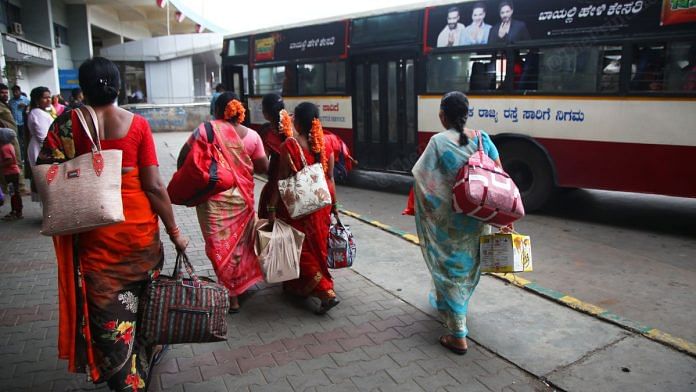Less than 25% of the Indian workforce is female and the contribution of women to India’s GDP is just 18%, one of the lowest proportions in the world. This untapped potential translates to a staggering loss for the nation amounting to billions of dollars. The low and declining female labour force participation rate demands immediate action.
According to a World Bank report, more women (45%) walk to work in India than men (27%) because they do not have access to affordable transport. This restricts their access to jobs located farther away and limits their job choices.
So what solutions can we implement to bridge the gap and encourage greater female participation in the workforce?
Affordable and reliable transport is key
Offering travel at as low as INR1 (less than $0.01) per kilometre, buses are the most affordable mode of transport for many. Travel at this price has the potential to become the gateway to economic freedom.
In India, there are also initiatives like free bus travel for women in Delhi and Bengaluru which are promising, but widespread issues like overcrowding, unreliable schedules and unpredictable waiting times still deter many.
India has only 10% of the buses that it needs so, as a result, waiting times are as long as 60-90 minutes sometimes, and unpredictable. If two buses come in quick succession, then the next bus could be more than two hours away. Waiting 45-60 minutes a day for the bus is common. During peak hours they may not even be able to board if it is already overcrowded.
Now, look at it from the woman’s perspective. A majority of the burden of domestic work falls on women in India. Imagine juggling household chores, childcare and a demanding job – time is their most precious commodity.
For countless Indian women, this tightrope walk is made impossible by the unreliable public transport which eats into their already stretched minutes. Finding work close to home then becomes a necessity, limiting their professional aspirations.
So what solutions can we implement to bridge the gap and encourage greater female participation in the workforce? A low cost, reliable way to get around can be a vital link between her home and economic empowerment, especially among the women in low-income groups who cannot afford an alternate mode of transportation.
Technology can change mobility solutions
While addition of buses involves a massive overhaul of the infrastructure, we found that technology has the potential to fundamentally change mobility solutions and can enable women and other vulnerable sections to go to work safely and affordably.
Live tracking
One way in which reliability can be introduced to the system is by offering live tracking of buses. More than 2 million passengers across 23 cities in India now check the live location of their bus daily on the Chalo App.
They know precisely when the bus will reach the bus stop. This is a blessing for women because they no longer have to wait at the bus stop, and they regain a part of their day, every day.
How significant is the impact? Let’s examine the case of Mumbai to understand. According to a report published by BEST, within three months of implementation, live tracking helped Mumbaikars save 100,000 (hu)man-days. By helping women in Mumbai and across India save time on travel, we can provide them with the required impetus to step out and seek employment.
As a technology, live tracking, showing real-time seat availability, and offering digital tickets are easy to implement, and yet we’re not doing this across all our buses as a mandate. In Mumbai alone, initiatives like these have helped increase women’s ridership in buses by 7%, so imagine the national impact if such solutions were universally adopted.
Integrated end-to-end mobility
Another aspect to consider while trying to solve for women’s travels is that women juggle multiple worlds – home, work, caregiving – and their travel reflects this complex reality.
They often embark on “trip chaining”, making several hops with different modes of transport. Imagine the stress of navigating crowded buses, unreliable schedules, and unpredictable connections. It takes precious time and energy, often deterring women from pursuing employment.
But what if their commutes were seamless? We can unlock this potential with a well-integrated transport system that includes:
● First mile, last mile solutions: E-bikes, micro-mobility options and feeder buses connecting to the bus system to make the start and end of their journeys efficient.
● Interconnected networks: Seamless transfers between buses, metros and trains with clear signage, live updates, and integrated ticketing reduce stress and save time.
● Trip planning and live tracking: Real-time information and trip plan, with shorter wait times and reliable connections, empower women to plan their day effectively.
● Integrated payments: A simple one-tap payment mechanism that works across all modes of transport can make it very easy to pay for travel.
Reduced commute times and door-to-door convenience can unlock valuable hours for women to dedicate to work, studies or personal care. It means more women accessing jobs farther away, opening doors to better opportunities and higher incomes.
In addition to all these efforts, to truly fuel women’s mobility, a key solution is integrating them into the system itself. Less than 5% of the commercial driving licences are held by women in India, according to our estimates.
We see very few women in operational roles that are an integral part of the bus ecosystem. Hence, efforts to educate and train more women for inclusive job roles becomes crucial.
Investing in an integrated and women-friendly transport system is not just about moving women; it’s about moving society forward. Let’s build a network that respects women’s time, needs and aspirations, and watch them break barriers and soar.
This article previously appeared in the World Economic Forum



